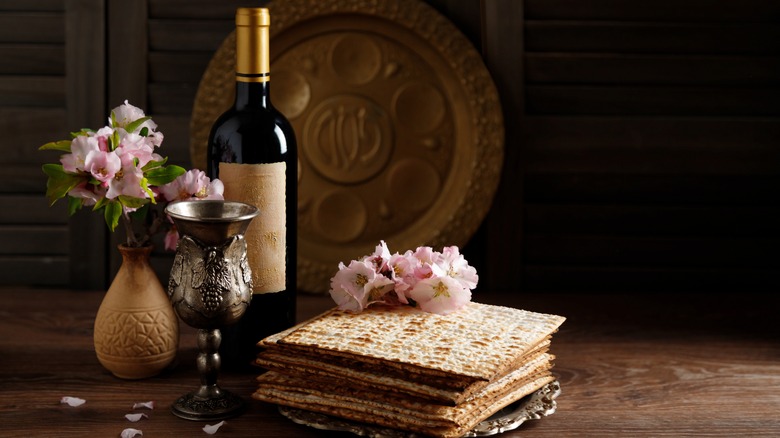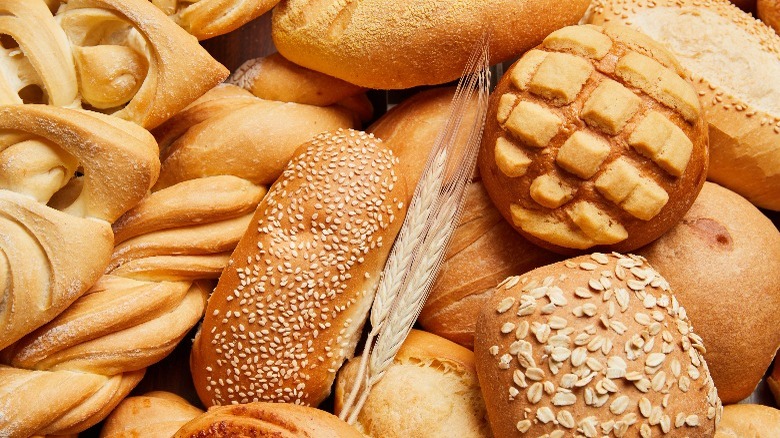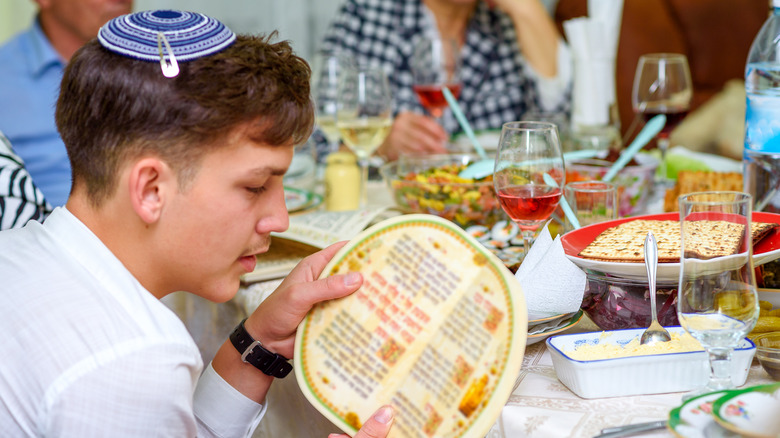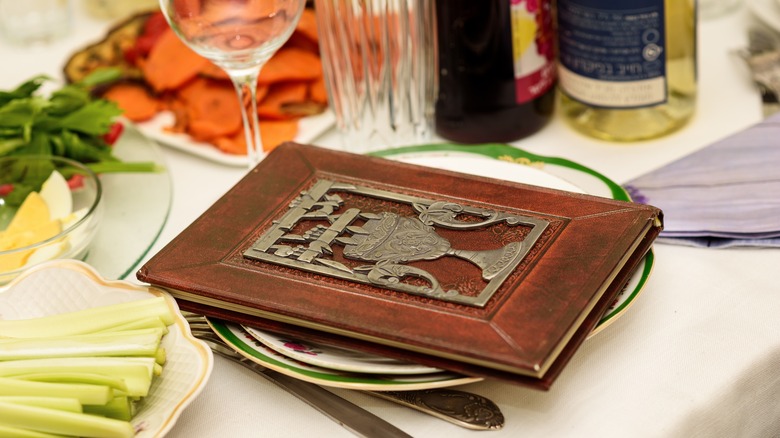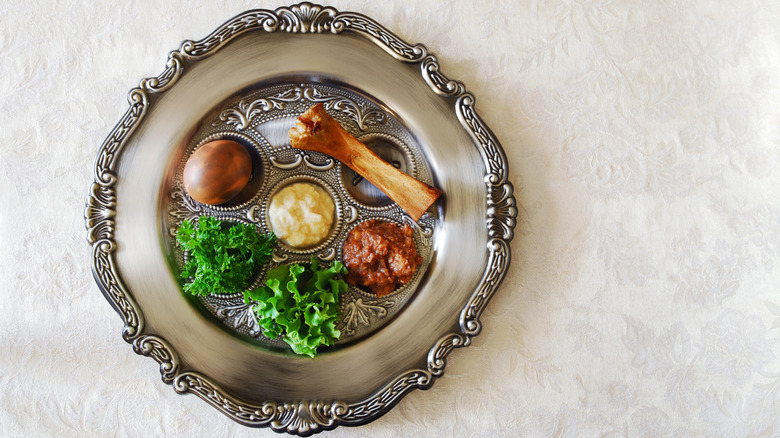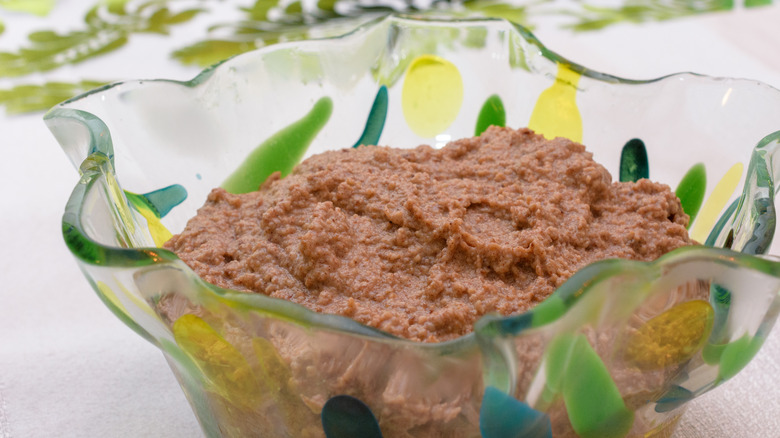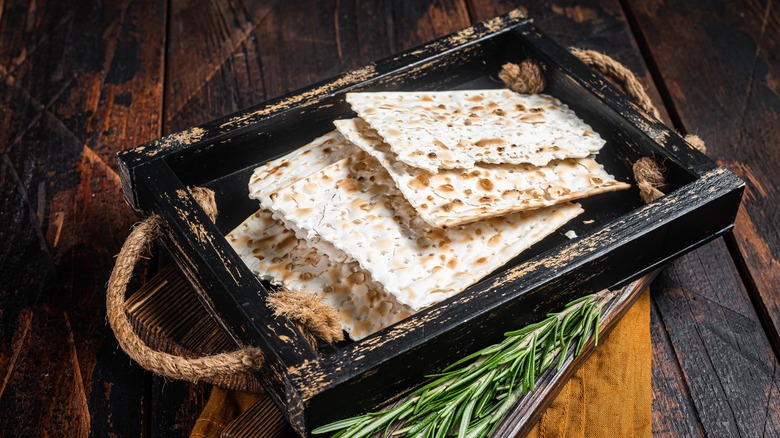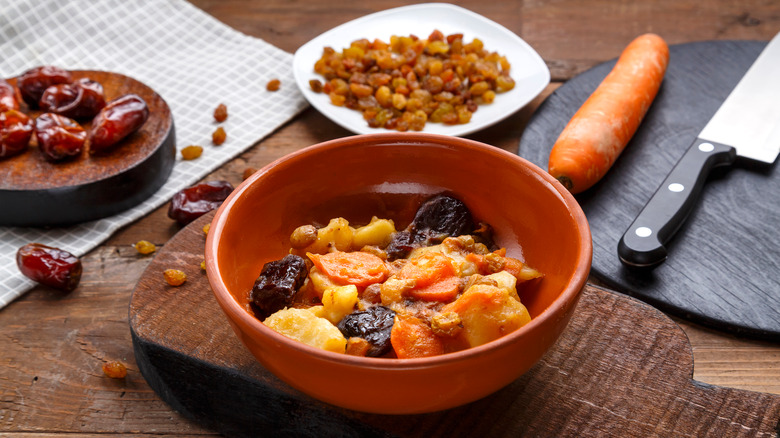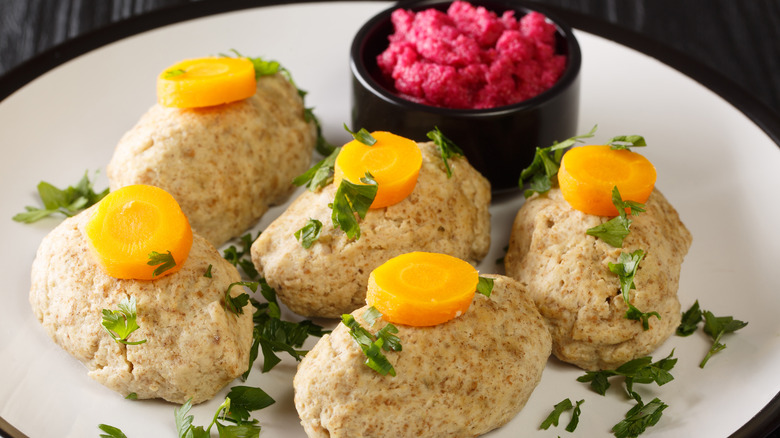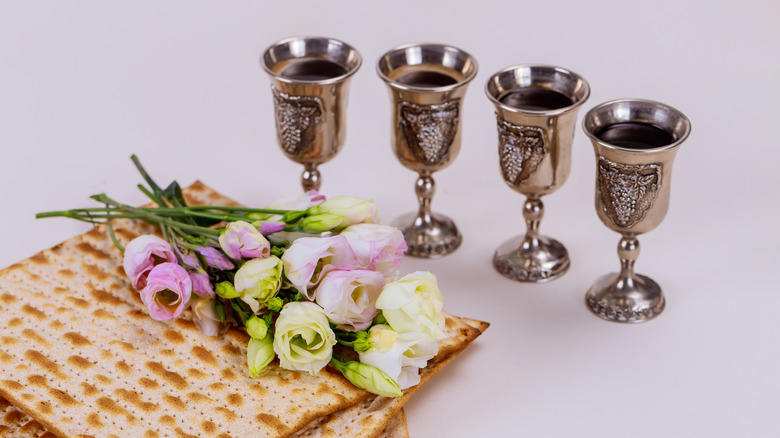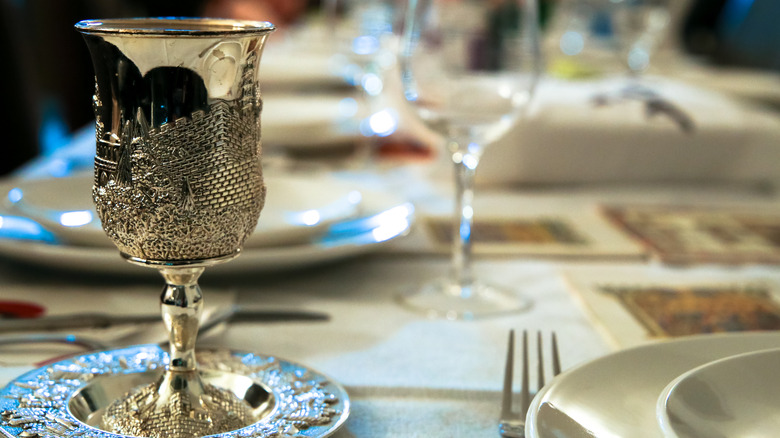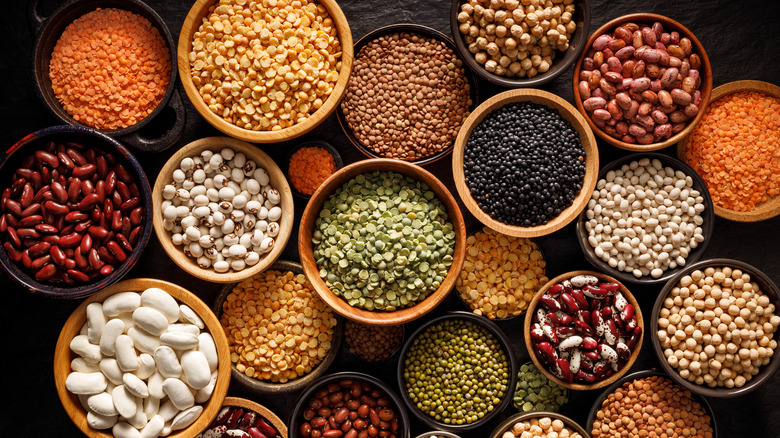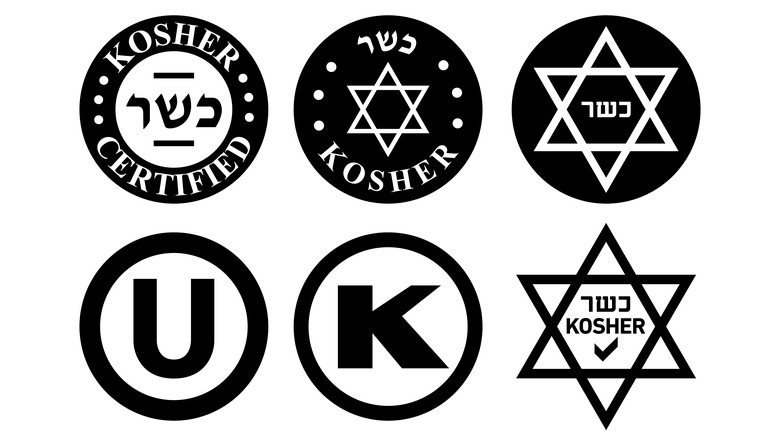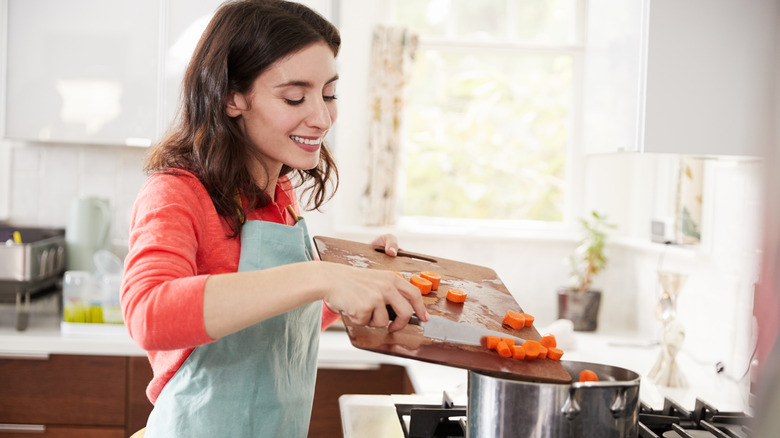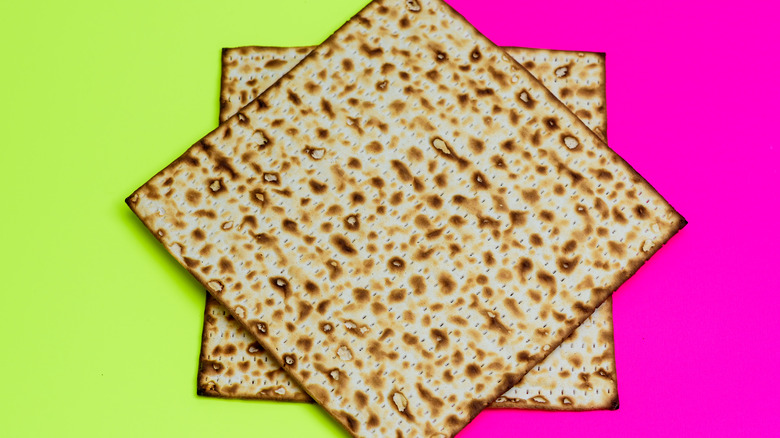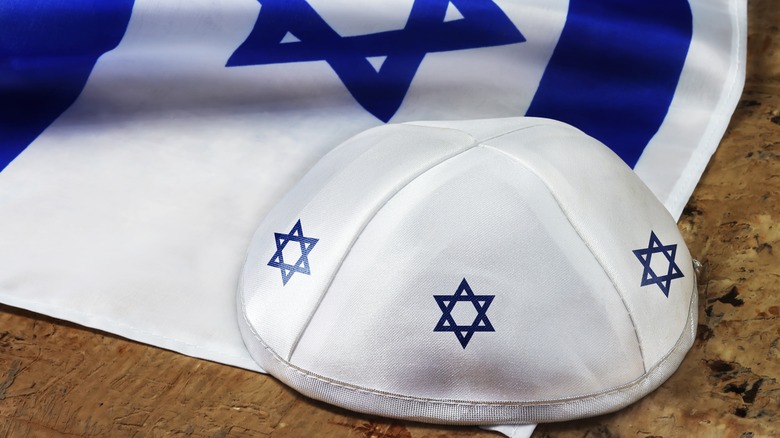The Ultimate Guide To Passover Food Traditions
Passover is one of the most widely-observed Jewish holidays. The celebration usually takes place in the month of March or April and lasts for seven or eight days. During this holiday, celebrants reflect on the Jewish people's escape from slavery in ancient Egypt and take part in several rituals, many of which are food-centric.
From a culinary perspective, Passover is fascinating due to the degree to which its customs revolve around food. Famous dishes like matzo, charoset, and tzimmes all have a place in the holiday. They shine during Passover Seder, big dinner gatherings which are the holiday's main focus. The food rituals included in these gatherings are integral to the celebration of Passover. These practices elicit a sense of community that binds followers of the Jewish faith together. In understanding these customs, we better understand the holiday and its message. Here is the ultimate guide to Passover food traditions.
Chametz
Chametz is one of the most significant food traditions of Passover. Its importance stems from the story that, during the Jews' escape from slavery in Ancient Egypt, they had to flee so quickly that they didn't have time for their bread to rise.
Since Passover reflects on this exodus, Jews do not consume any leavened grain products (Chametz) during the holiday. Chametz includes bread made of wheat, rye, barley, oats, or spelt that is not fully cooked within 18 minutes after having liquid added to it. This ban extends to cakes, cookies, or pasta made with prohibited ingredients.
Before the beginning of Passover, Jewish homes get thoroughly cleaned and all chametz is removed. Any item that may have come into contact with these foods undergoes sanitization. Some non-food items that could potentially contain chametz are discarded. On the eve before the Passover Seder, the entire house should be ritually searched for any chametz and pronounced free of chametz before a ritual nullification statement is made.
Seder
The Seder is a ritual family meal celebrated near the beginning of Passover, usually on the first night of Passover. The word "Seder" comes from the Hebrew term meaning "order," referring to the particular order followed for the meal. This gathering includes a 15-part ceremony intended to engage the entire family, including the children, in retelling the Exodus of Jews from Egypt.
The evening begins with kadesh, or blessing. This is followed by urchatz, a step in which dinner guests ritually wash their hands. Several steps follow throughout a Passover Seder. Interspersed with storytelling, Seder guests consume various symbols. They pour wine, say blessings, and eat dinner.
Near the end of the meal, a hide-and-seek type game is played. During it, adults hide a piece of matzo wrapped in cloth. This object is referred to as the afikomen. Then, Seder guests (usually the children) go out and try to be the first person to find the afikomen. Overall, Passover Seder is an event filled with songs, laughter, storytelling, and prayers. It is a joyful evening of solemn worship combined with culinary traditions.
Haggadah
During Passover Seder, a book called the Haggadah is used to guide Seder guests through important rituals. According to Judaism 101, one of the most famous lines from the Haggadah is: "Why is this night different from all other nights?"
The term "Haggadah" translates to "telling." This is essentially what the Haggadah does during Passover. It retells the Exodus story and illustrates the rules of how to commemorate it. The Haggadah also outlines Passover rituals like prayers and songs. It even explains the culinary traditions of the holiday.
While a Haggadah can be purchased, some families choose to create their own with the hopes of infusing the text with their unique family traditions. Whichever Haggadah one chooses, the key is to involve everyone at the table in its reading. Passages should be read in succession, alternating from person to person, maintaining the unity and identity of those in attendance.
Foods of the Seder plate
The Passover Seder plate is a special piece of flatware used during the meal. It usually contains six compartments each dedicated to holding different foods.The design of the plate emphasizes the importance of one of these special dishes. During the holiday, these items are not just foods, they are symbols.
The passover foods of zeroa, beitzah, maror, charoset, chazeret, and karpas each have a spot on a Passover Seder plate. Zeroa is a lamb shank bone. Beitzah is a hard-boiled egg. Maror consists of bitter herbs such as grated horseradish. Charoset is a fruit and nut paste. Karpas is usually parsley. Chazeret consists of romaine lettuce.
Each food symbolizes a different part of the Passover story of the Jews' escape from slavery. For example, the bitterness of horseradish (or other spicy herbs used for maror) signifies the bitterness of slavery. Other foods eaten during Passover include gefilte fish, tzimmes, and matzo.
Charoset
Charoset is one of the prepared foods that appears on the Passover Seder plate. It consists of a thick paste generally made of various dried fruits and nuts. At certain points during the night, other Seder plate foods such as maror are dipped into charoset.
The name "charoset" comes from the Hebrew word "cheres," which means "clay." This translation is the basis of the charoset's use as a symbol for the mortar used by Jews to construct Egyptian structures while they were enslaved. In another interpretation, charoset symbolizes apple trees growing in Egypt. Before their escape, Jewish women would reportedly give birth near these trees to hide newborn male sons from their oppressors.
Variations on charoset recipes are diverse. Elements commonly included are apples, figs, pomegranates, grapes, walnuts, dates, wine, saffron, and cinnamon. Sometimes, ingredients like chestnuts and coconut are also used to make charoset. This paste, while symbolic, is also delectable when spread onto a piece of matzo.
Matzo
During the Passover Seder, you also eat matzo. It is an unleavened type of bread eaten during Passover to symbolize how, while escaping from slavery, Jews had to leave so quickly that they didn't have time for their bread to rise. It takes the place of chametz foods which can't be eaten during the holiday.
Matzo has a cracker-like texture and a neutral flavor. It may not have a special compartment on the Passover Seder plate, but it does have a designated place on the dinner table. Three pieces of Matzo are usually stacked on the table's surface. Each serves as a symbol that is used in different parts of the Passover story throughout the night. The pieces are ritually broken during this storytelling. Even these broken pieces of matzo are used to symbolize concepts during the Seder. They are used as physical examples of the price of freedom, among other things.
Tzimmes
Tzimmes is a sweet and savory stew. It is typically served as part of Rosh Hashanah, another important holiday in Judaism that marks the Jewish New Year. But tzimmes can also make an appearance at Passover. The dish derives its name from the Yiddish term for "a fuss," presumably because it takes a lot of effort to peel all the vegetables needed to make this dish.
As a symbol, tzimmes is meant to embody prosperity. The belief is that consuming this dish will bring luck and good fortune in the coming year. Since so much of the Passover Seder involves looking toward the future with hope, it makes sense to include it here, too.
Variations on tzimmes are common. But carrots, sweet potatoes, and prunes are standard ingredients used in the recipe. Sweetness is transferred to the stew using honey and other components. Tzimmes is also made with spices like cinnamon, nutmeg, and cloves. It can be made on the stovetop or in the oven.
Gefilte fish
Gefilte fish is a ground seafood dish made of carp, pike, or other whitefish. During preparation, the food is shaped into oblong patties and poached. This dish is often served during Passover Seder.
Historically speaking, fish represent a powerful symbol in Judaism. The animals are used to represent fertility and the coming of the Messiah. Jews believe that when the Messiah arrives, he might appear in the form of a fish. Fish are also a convenient food to consume when adhering to a kosher diet. This is because fish can be combined with meat or dairy without restrictions.
While commercially-produced gefilte fish is available in numerous permutations, some people like to make their own version of the recipe inspired by local culinary traditions. For those who wonder what gefilte fish tastes like, we can only describe it as something akin to eating a slightly fishy-yet-sweet meatloaf. It is perhaps an acquired taste, but one that many who grew up in Jewish households have come to love.
Four cups of wine
Another important food tradition during Passover Seder is the consumption of four cups of wine. The Haggadah outlines specific rules for this tradition, including when and how to enjoy the beverages. There are many different explanations for the number four being chosen for this wine tradition.
The four cups of wine are meant to be enjoyed while sitting in a reclined position. Some say this position signifies freedom. Others say the drinking posture is meant to mimic the royals during ancient times. While these instructions may already sound pretty specific, there are even more rules concerning the four cups of wine. For example, each wine cup must be able to hold 3.8 ounces of liquid. As for the type of beverage, red wines are preferred. The wine must also be kosher for Passover, a term that means the beverage is not only kosher, but also has not come in contact with any chametz. Many people purchase their wine from the brand Manischewitz, a company that specializes in making kosher products.
Elijah's cup
Near the end of the Passover Seder, a cup of wine gets poured for the prophet Elijah. This cup of wine is strictly ceremonial and never consumed by anyone. Elijah's cup is yet another example of the intricacy with which food and beverages have become so carefully woven into the Passover traditions.
This Passover ritual has a few different parts. First, Elijah's cup is filled with wine. Next, someone at Passover opens the front door, which symbolizes the possibility of Elijah walking through it. Finally, certain verses are repeated to mark this moment in the Seder.
This big, symbolic welcome party is being set up for Elijah because the prophet's potential arrival at the Seder is meant to symbolize the return of the Messiah. As you may be able to tell, this step in the Passover story is signaling a shift for guests to look toward the future, instead of reflecting on the past.
Kitniyot
In addition to chametz, there is another food group that is avoided during Passover. These foods are called kitniyot. Why these foods are avoided is multifaceted.
One reason is to avoid confusing any of these foods with those prohibited during Passover, as part of chametz. Many of these foods are processed into flour, meaning they could easily be confused with the prohibited grain products. Another reason for avoiding kitniyot is possible cross-contamination. These foods may have been exposed to chametz while they were being grown or processed. It's recommended that kitniyot are avoided out of an abundance of caution. However, these things are not as strictly prohibited as chametz. Not everyone avoids eating them during Passover.
Peanuts, beans, caraway, cardamom, corn, fennel seeds, lentils, mustard, rapeseed, soybeans, and sunflower seeds are all a part of kitniyot. However, the specific food items considered to be kitniyot can vary, depending on who you ask.
Kosher for Passover
In Judaism, the list of dietary rules to be followed is called Kashrut. Foods that follow these rules are dubbed kosher. In addition to bans on pork and shellfish, eating meat with dairy, and preparing meat with dairy, animals not slaughtered in adherence to specific rules are also forbidden by the kosher diet. During Passover, however, there is added concern over anything considered chametz. These include foods prepared, processed, or otherwise contaminated with chametz.
Therefore, many foods around the time of year surrounding Passover get labeled "kosher for Passover." A food item without these words on the packaging may have several other symbols indicating they are safe to consume. There are also quite a few kosher for Passover recipes out there.
Kosher certifications are given to reputable companies that follow strict regulations. An example of one such company is Manischewitz. There are around 18 foods that do not require a kosher for Passover certification. Eggs, meat, poultry, milk, nuts, bottled water, and frozen fruit are all exempt.
Passover is a Chag, but you can still cook
According to the Torah, all Jewish holidays (or Chag) begin in the evening and end in the evening. With many of these holidays, certain restrictions go into effect, including the cessation of any work or school activities. Things like driving, using electronic devices, and cooking are sometimes prohibited. All of these activities must cease one hour before sundown on the evening of the holiday commencing.
One notable exception to this rule is Passover. During this holiday, cooking is not only allowed, but encouraged. Because of the centrality of the Seder and the ritual of the foods consumed during the meal, Passover necessitates the work of food preparation. The holiday is not appropriately celebrated otherwise. The fact that this exception is made reflects the importance of this holiday to the Jewish faith. Indeed, even when Passover occurs during the Sabbath — another time when cooking is prohibited — food preparation is still allowed.
Modern Seder plate variations
A newer Passover food tradition trend inspires dinner guests to decorate the Seder plate with modern additions representative of more current social issues.
Orange segments are incorporated to support the LGBTQ movement. Small, red potatoes are eaten along with the bitter herbs, acknowledging the exodus of Ethiopian Jews to Israel. Fair-trade chocolate can be served as a reminder that forced labor is a form of modern-day slavery. A banana could appear to honor the plight of refugees fleeing from their homes in war-torn countries globally. Cashews may find a place on the plate to serve as a sobering reminder of American soldiers who often rely on nuts for sustenance. Finally, an acorn could appear to signify a commitment to reparations for Indigenous people in the United States.
Outside of the Seder plate, other new food traditions are being followed. In one of them, an empty cup, called Miriam's cup, is added. It is placed alongside Elijah's cup and filled with water by each of the attendees at the Seder. This ritual is meant to recognize women's equality.
The difference between Ashkenazi and Sephardi foods
Ashkenazi and Sephardi Jews, while mostly similar in their fundamental beliefs, are two distinct Jewish subcultures. Ashkenazi Jews are the descendants of people from Central or Eastern Europe. Sephardic Jews can trace their lineage back to Portugal, Spain, the Middle East, or North Africa. Within this category, Sephardi Jews are sometimes further divided into Sephardim (Jews from Spain or Portugal) and Mizrachim (Jews from North Africa and the Middle East).
From a culinary perspective, Ashkenazi and Sephardi Jews differ widely. The differences in these cuisines are a product of the distinct climates and geographies of their places of origin. The colder northern climates favor heavier foods, including potatoes, noodles, pasta, bread, meat, and pickled foods. Countries in North Africa and the Middle East have much warmer climates. These cuisines are known for using a more diverse variety of fruits, vegetables, seafood, spices, and olive oil.
